It’s back to school time, and what better way for teachers to begin building those special relationships with students than sharing books together? Reading aloud, literature circles, independent reading, group sharing and simply sending kids home with books promotes the excitement of reading and sharing a good story in school and at home. This week the International Reading Association Children's Literature and Reading Special Interest Group (CL/R SIG) provides a list of books to start an exciting new school year with funny stories, thoughtful stories, and lunch box facts! ReadWriteThink offers several pages of back to school reading lesson plan ideas to help teachers begin a successful school year.
GRADES K-3
Adams, Diane. (2012). I Want to Help. Illustrated by Nancy Hayashi. Peachtree.
 Emily Pearl is back after appearing in her first book, I Can Do It Myself (2009). Ms. Glenn, Emily’s kindergarten teacher, is not always anxious for the kind of help that Emily offers. Hayashi’s illustrations reveal the reality of each scene with Emily’s so-called help in the classroom. The illustrations will make good discussion starters with young students as they observe, for example, Emily’s overactive exuberance to help around Ms. Glenn’s classroom when she pushes other kids out of the way to do such classroom tasks as pass out papers, play baseball and soccer, swing on the monkeybars, pass out cupcakes, stack the building blocks and other school activities. When her father is late picking her up after school and she is the only student left in the classroom, she is a bit scared. Her astute teacher senses that fear and tells Emily Pearl that she needs her help. Teachers might like to use this book with the ReadWriteThink lesson entitled “Catching the Bug for Reading Through Interactive Read Alouds” or “Using Children’s Natural Curiosity to Lead to Descriptive Writing.” Learn more about this author and her books at her website.
Emily Pearl is back after appearing in her first book, I Can Do It Myself (2009). Ms. Glenn, Emily’s kindergarten teacher, is not always anxious for the kind of help that Emily offers. Hayashi’s illustrations reveal the reality of each scene with Emily’s so-called help in the classroom. The illustrations will make good discussion starters with young students as they observe, for example, Emily’s overactive exuberance to help around Ms. Glenn’s classroom when she pushes other kids out of the way to do such classroom tasks as pass out papers, play baseball and soccer, swing on the monkeybars, pass out cupcakes, stack the building blocks and other school activities. When her father is late picking her up after school and she is the only student left in the classroom, she is a bit scared. Her astute teacher senses that fear and tells Emily Pearl that she needs her help. Teachers might like to use this book with the ReadWriteThink lesson entitled “Catching the Bug for Reading Through Interactive Read Alouds” or “Using Children’s Natural Curiosity to Lead to Descriptive Writing.” Learn more about this author and her books at her website.
- Karen Hildebrand, Ohio Library and Reading Consultant
Adderson, Caroline. (2012). Jasper John Dooley: Star of the Week. Illus. by Ben Clanton. Toronto: Kids Can Press.
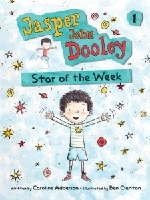 In this first title in a planned chapter book series likely to appeal to boy readers who resemble the protagonist, Jasper John Dooley vividly illustrates the wonders and woes of elementary school. In this introductory story, Jasper is thrilled to be named the class Star of the Week, and he eagerly anticipates showing his classmates his jewelry box filled with treasures. But these treasures aren’t sea glass, shells, buttons, or even insects. Instead, he has a collection of different colors of lint removed from the dryer screen and a small collection of lint from his father's belly button. "Yuck!" pretty much sums up his classmates' reaction to the collection, and Jasper finds being the Star of the Week less satisfying than he expected it to be. While his best friend Ori loses sleep due to a new baby, Jasper tries to persuade his parents that their family is too small. The descriptions of the voice of his teacher Ms. Tosh are spot-on, showing how it changes according to whether she believes what she is hearing and proving that children are more aware than some adults assume. For the most part, Jasper is blissfully unconcerned about what others think about his uniqueness. After all, he has supportive parents who give him enough space to explore his own interests. Readers will clamor for more from this unlikely but likeable and free-spirited hero.
In this first title in a planned chapter book series likely to appeal to boy readers who resemble the protagonist, Jasper John Dooley vividly illustrates the wonders and woes of elementary school. In this introductory story, Jasper is thrilled to be named the class Star of the Week, and he eagerly anticipates showing his classmates his jewelry box filled with treasures. But these treasures aren’t sea glass, shells, buttons, or even insects. Instead, he has a collection of different colors of lint removed from the dryer screen and a small collection of lint from his father's belly button. "Yuck!" pretty much sums up his classmates' reaction to the collection, and Jasper finds being the Star of the Week less satisfying than he expected it to be. While his best friend Ori loses sleep due to a new baby, Jasper tries to persuade his parents that their family is too small. The descriptions of the voice of his teacher Ms. Tosh are spot-on, showing how it changes according to whether she believes what she is hearing and proving that children are more aware than some adults assume. For the most part, Jasper is blissfully unconcerned about what others think about his uniqueness. After all, he has supportive parents who give him enough space to explore his own interests. Readers will clamor for more from this unlikely but likeable and free-spirited hero.
- Barbara A. Ward, Washington State University Pullman
Barnett, Mac. (2012). Oh no! Not again! (or, How I built a time machine to save history) (or at least my history grade). Illustrated by Dan Santat. Disney-Hyperion.
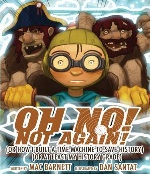 This book is busy from stem to stern, end paper to end paper, cover to cover including the back of the dust jacket which sports a movie poster of the storyline. The super smart student in this story has missed one answer on her history test and is incensed! Her solution is to build a time machine and go back and change history to make her answer right. Sparse text and lively action packed illustrations reveal the story. When a few first attempts with the time machine go awry, she finally transports to the correct time period only to find cavemen who do not quite understand art. For instance, the paintbrushes end up in their noses and the spray paint is just plain fun to splatter each other. While our determined student takes the matter into her own hands to create the cave painting, the early man pair take a spin in the time machine. The end of the book supplies possible routes for other time machine adventures that teachers might like to use for writing prompts. Fans of team Barnett and Santat will like the pair’s earlier book, Oh, No! based on a science-fair project run amok. Visit the author’s website for more information about his books or check out this blog for using his books as a possible author study.
This book is busy from stem to stern, end paper to end paper, cover to cover including the back of the dust jacket which sports a movie poster of the storyline. The super smart student in this story has missed one answer on her history test and is incensed! Her solution is to build a time machine and go back and change history to make her answer right. Sparse text and lively action packed illustrations reveal the story. When a few first attempts with the time machine go awry, she finally transports to the correct time period only to find cavemen who do not quite understand art. For instance, the paintbrushes end up in their noses and the spray paint is just plain fun to splatter each other. While our determined student takes the matter into her own hands to create the cave painting, the early man pair take a spin in the time machine. The end of the book supplies possible routes for other time machine adventures that teachers might like to use for writing prompts. Fans of team Barnett and Santat will like the pair’s earlier book, Oh, No! based on a science-fair project run amok. Visit the author’s website for more information about his books or check out this blog for using his books as a possible author study.
- Karen Hildebrand, Ohio Library and Reading Consultant
Calmenson, Stephanie. (2012). Oopsy, teacher! Illustrated by Sachiko Yoshikawa. Carolrhoda Books.
 Mr. Bungles is having a bad day just like he did in Calmenson’s earlier book about Mr. Bungles, Late for School (2008). He bumps his head to start his day and then gets soap in his eyes and jam on his tie, and when he finally gets to school the classroom hamster, Nibbles, is on the loose! Mr. Bungles and his students are on the run after the hamster – around the school, around the track, and into town where they find him at the local pizza shop happily nibbling on some pepperoni. Yoshikawa’s bright and playful illustrations complement the humor and fast action of the story. This will be a good read aloud and maybe an introduction to taking care of the class pet. Calmenson likes to write early school stories and more can be found at her publisher’s website or at her own website. Another new book from author Stephanie Calmenson is the interactive response book Ollie’s School Day; a yes-and-no book.
Mr. Bungles is having a bad day just like he did in Calmenson’s earlier book about Mr. Bungles, Late for School (2008). He bumps his head to start his day and then gets soap in his eyes and jam on his tie, and when he finally gets to school the classroom hamster, Nibbles, is on the loose! Mr. Bungles and his students are on the run after the hamster – around the school, around the track, and into town where they find him at the local pizza shop happily nibbling on some pepperoni. Yoshikawa’s bright and playful illustrations complement the humor and fast action of the story. This will be a good read aloud and maybe an introduction to taking care of the class pet. Calmenson likes to write early school stories and more can be found at her publisher’s website or at her own website. Another new book from author Stephanie Calmenson is the interactive response book Ollie’s School Day; a yes-and-no book.
- Karen Hildebrand, Ohio Library and Reading Consultant
Harley, Bill. (2012). Lost and found. Illus. by Adam Gustavson. Atlanta: Peachtree Publishers.
 Stories based only on rumor and assumptions often gather momentum in schools, sometimes prompting students to avoid certain individuals or parts of the building. In Justin’s case, he and his classmates fear the grumpy elderly janitor who keeps the school clean and picks up lost items. When he loses the hat his grandmother knitted for him, Justin dreads asking Mr. Rumkovsky for help, but his mother insists that he find that hat, even the halls leading to the janitor’s office are dark and frightening. But it turns out that Mr. Rumkovsky is a kindly man, not scary at all. As Justin peers into the box containing items found by the janitor, he spies several things his classmates have lost but never had the nerve to look for or claim. In fact, when Justin finally finds the hat he has been looking for, he realizes that he and his mother have something in common when it comes to hats and groundless fears. The narrator’s voice is clear in this story, typified by the phrase "I knew that already" (unpaged), which certainly sounds like a youngster's voice. The illustrations, consisting of oil on watercolor paper, are lively and amusing as Justin comes face to face with all sorts of long-lost stuff for which no one has bothered to look very hard, perhaps because they don’t miss it all that much. Musical Bill Harley has a fun-filled and action-packed website for teachers that include songs, lesson plans and other activities.
Stories based only on rumor and assumptions often gather momentum in schools, sometimes prompting students to avoid certain individuals or parts of the building. In Justin’s case, he and his classmates fear the grumpy elderly janitor who keeps the school clean and picks up lost items. When he loses the hat his grandmother knitted for him, Justin dreads asking Mr. Rumkovsky for help, but his mother insists that he find that hat, even the halls leading to the janitor’s office are dark and frightening. But it turns out that Mr. Rumkovsky is a kindly man, not scary at all. As Justin peers into the box containing items found by the janitor, he spies several things his classmates have lost but never had the nerve to look for or claim. In fact, when Justin finally finds the hat he has been looking for, he realizes that he and his mother have something in common when it comes to hats and groundless fears. The narrator’s voice is clear in this story, typified by the phrase "I knew that already" (unpaged), which certainly sounds like a youngster's voice. The illustrations, consisting of oil on watercolor paper, are lively and amusing as Justin comes face to face with all sorts of long-lost stuff for which no one has bothered to look very hard, perhaps because they don’t miss it all that much. Musical Bill Harley has a fun-filled and action-packed website for teachers that include songs, lesson plans and other activities.
- Barbara A. Ward, Washington State University Pullman
Hills, Tad. (2012). Rocket writes a story. New York: Schwartz & Wade Books/ Random House.
 By the author and illustrator of How Rocket Learned to Read, this new picture book could easily jumpstart writing workshop in primary grades. Rocket sniffs out some new words and writes them down on sticky notes—buttercup, bug, feather, and nest. With the help of little yellow bird, his teacher, he reads all of his splendid words and announces, “I’m going to write a story!” But he experiences something many writers go through, he stares at the blank pages and no story comes. Yellow bird suggests he think about characters and something that has happened to him. In addition, walking, sniffing, drawing, and visiting his favorite tree help Rocket begin to slowly craft a story. Rocket’s persistence, revision and help from friends also help. Finally he completes his tale and he celebrates by reading it aloud to a new pal. Each step of Rocket’s writing process is exactly what young writers will experience as they learn to write this coming school year. Visit the author’s website to watch meet the real Rocket and view videos.
By the author and illustrator of How Rocket Learned to Read, this new picture book could easily jumpstart writing workshop in primary grades. Rocket sniffs out some new words and writes them down on sticky notes—buttercup, bug, feather, and nest. With the help of little yellow bird, his teacher, he reads all of his splendid words and announces, “I’m going to write a story!” But he experiences something many writers go through, he stares at the blank pages and no story comes. Yellow bird suggests he think about characters and something that has happened to him. In addition, walking, sniffing, drawing, and visiting his favorite tree help Rocket begin to slowly craft a story. Rocket’s persistence, revision and help from friends also help. Finally he completes his tale and he celebrates by reading it aloud to a new pal. Each step of Rocket’s writing process is exactly what young writers will experience as they learn to write this coming school year. Visit the author’s website to watch meet the real Rocket and view videos.
- Deanna Day, Washington State University Vancouver
Ransome, James. (2012). My teacher. New York: Dial.
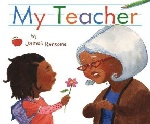 A perfect gift for a teacher on the first or last day of school, this picture book is the author’s thank-you note to hard-working educators. Throughout the book’s pages the narrator ponders her teacher's career longevity. After wondering why she "keeps teaching here" (unpaginated), the student then begins listing the possible appeal of teaching in this particular school. This dedicated teacher somehow finds time to create community, fill the classroom shelves with books while fostering the love for reading. She also inspires the students to write and integrates art and music within the classroom. As every effective teacher knows, the students are a large part of why teachers keep teaching. With no mention of high-stakes testing or Common Core State Standards, this picture book is certainly a nostalgic look at teachers and all they do to make a difference in their students’ lives. The illustrations are every teacher’s delight, filled with highly engaged and motivated students eager to learn. Teachers will smile when they see the apple-pattern-filled vest this woman is wearing. Since all teachers have days when they could use a little encouragement, this book provides a reminder that teachers CAN change lives and provide positive examples for their young charges.
A perfect gift for a teacher on the first or last day of school, this picture book is the author’s thank-you note to hard-working educators. Throughout the book’s pages the narrator ponders her teacher's career longevity. After wondering why she "keeps teaching here" (unpaginated), the student then begins listing the possible appeal of teaching in this particular school. This dedicated teacher somehow finds time to create community, fill the classroom shelves with books while fostering the love for reading. She also inspires the students to write and integrates art and music within the classroom. As every effective teacher knows, the students are a large part of why teachers keep teaching. With no mention of high-stakes testing or Common Core State Standards, this picture book is certainly a nostalgic look at teachers and all they do to make a difference in their students’ lives. The illustrations are every teacher’s delight, filled with highly engaged and motivated students eager to learn. Teachers will smile when they see the apple-pattern-filled vest this woman is wearing. Since all teachers have days when they could use a little encouragement, this book provides a reminder that teachers CAN change lives and provide positive examples for their young charges.
- Barbara A. Ward, Washington State University Pullman
Van Lieshourt, Maria. (2012). Backseat A-B-See. San Francisco, CA: Chronicle Books.
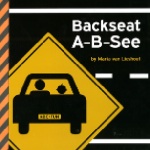 This ABC book begins with, “Vroom! Vroom! From the backseat, what do you see?” Young children will follow the black road with the dotted white lines to each letter of the alphabet and the road signs that accompany each letter beginning with A for airport and B for bike route. In this fun and colorful book other road signs state L is for library, M is for merge and N is for no entry. This is perfect for children learning the alphabet and reading environmental print. Children will make connections to these road signs and become a backseat driver in their parents’ vehicles. Check out the book trailer online.
This ABC book begins with, “Vroom! Vroom! From the backseat, what do you see?” Young children will follow the black road with the dotted white lines to each letter of the alphabet and the road signs that accompany each letter beginning with A for airport and B for bike route. In this fun and colorful book other road signs state L is for library, M is for merge and N is for no entry. This is perfect for children learning the alphabet and reading environmental print. Children will make connections to these road signs and become a backseat driver in their parents’ vehicles. Check out the book trailer online.
- Deanna Day, Washington State University, Vancouver
Yum, Hyewon. (2012). Mom, it’s my first day of kindergarten! New York: Frances Foster Books/Farrar Straus Giroux.
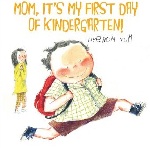 The end pages showcase an eager five-year-old boy getting ready for school. On the first page the little boy shouts, “Mom, wake up! It’s my first day of kindergarten!” In the accompanying illustration the mom’s head peeks out from under the covers with an anxious face. She is illustrated in gray tones whereas the boy is in bold colors. This mom is not ready for her son to attend the big kids’ school. She is worried that there might not be enough snacks for her son in kindergarten. She wonders if she packed all of his school supplies. She also thinks he is still too little. Her son reassures her by saying, “Mom, don’t worry. I’ll be fine, I am already five!” Many young children will begin school for the first time this year, and this humorous book presents what many parents will be feeling. Read aloud this picture book during open house or curriculum night to reassure parents that their children are ready for big-kid school. Author, Hyewon Yum, shares her writing process at this blog.
The end pages showcase an eager five-year-old boy getting ready for school. On the first page the little boy shouts, “Mom, wake up! It’s my first day of kindergarten!” In the accompanying illustration the mom’s head peeks out from under the covers with an anxious face. She is illustrated in gray tones whereas the boy is in bold colors. This mom is not ready for her son to attend the big kids’ school. She is worried that there might not be enough snacks for her son in kindergarten. She wonders if she packed all of his school supplies. She also thinks he is still too little. Her son reassures her by saying, “Mom, don’t worry. I’ll be fine, I am already five!” Many young children will begin school for the first time this year, and this humorous book presents what many parents will be feeling. Read aloud this picture book during open house or curriculum night to reassure parents that their children are ready for big-kid school. Author, Hyewon Yum, shares her writing process at this blog.
- Deanna Day, Washington State University, Vancouver
GRADES 3-6
Angleberger, Tom. (2012). The secret of the fortune wookiee. New York: Harry N. Abrams/Amulet Books.
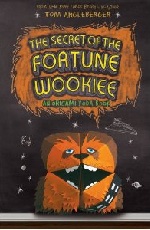 McQuarrie Middle School simply isn’t the same without Dwight, who created the wise Origami Yoda who always seems to have the right answer to the students’ problems. Having been suspended from McQuarrie, Dwight now attends Tippett Academy where he is trying to stay out of trouble and blend in with the rest of his new classmates. But the students there treat Dwight as though he were a pet. Because Tommy and Dwight’s other friends at McQuarrie wonder how to save Dwight from mediocrity or losing his uniqueness and becoming just like everyone else, Tommy begins a case file. After all, doing so helped the students resolve their differences and get along better in the earlier two titles in this creative Star Wars-themed series, The Strange Case of Origami Yoda (Abrams, 2010), and Darth Paper Strikes Back (Abrams, 2011). When Sara, Tommy's girlfriend, shows up with an origami fortune teller that looks just like Chewbacca from the Star Wars films, he seems to possess the same wisdom as Origami Yoda. Tommy's case file reveals the truth about what's going on as one by one, his friends speak their piece. As in the case of the other two titles, this one is filled with humor and profundity and examples of how boys and girls differ in solving problems. As the school principal, Mrs. Rabbski replaces the students' electives with test preparation periods through a program called Funtime! Time to Focus on the FUN-damentals!, Tommy and his friends prepare for their next great battle. Readers will eagerly await the next title to find out whether the Force will be strong enough to combat the academic change that looms over the school.
McQuarrie Middle School simply isn’t the same without Dwight, who created the wise Origami Yoda who always seems to have the right answer to the students’ problems. Having been suspended from McQuarrie, Dwight now attends Tippett Academy where he is trying to stay out of trouble and blend in with the rest of his new classmates. But the students there treat Dwight as though he were a pet. Because Tommy and Dwight’s other friends at McQuarrie wonder how to save Dwight from mediocrity or losing his uniqueness and becoming just like everyone else, Tommy begins a case file. After all, doing so helped the students resolve their differences and get along better in the earlier two titles in this creative Star Wars-themed series, The Strange Case of Origami Yoda (Abrams, 2010), and Darth Paper Strikes Back (Abrams, 2011). When Sara, Tommy's girlfriend, shows up with an origami fortune teller that looks just like Chewbacca from the Star Wars films, he seems to possess the same wisdom as Origami Yoda. Tommy's case file reveals the truth about what's going on as one by one, his friends speak their piece. As in the case of the other two titles, this one is filled with humor and profundity and examples of how boys and girls differ in solving problems. As the school principal, Mrs. Rabbski replaces the students' electives with test preparation periods through a program called Funtime! Time to Focus on the FUN-damentals!, Tommy and his friends prepare for their next great battle. Readers will eagerly await the next title to find out whether the Force will be strong enough to combat the academic change that looms over the school.
- Barbara A. Ward, Washington State University Pullman
Graff, Lisa. (2012). Double dog dare. New York: Philomel.
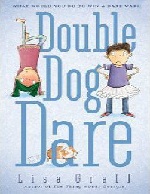 Francine Halata has always wanted to claim the news anchor spot, and when she and Kansas Bloom, a student new to the school, get the same number of votes for the position, another classmate suggests that the prize should go to the individual who accepts the most dares. The ensuing humorous and barf-filled competition involves all sorts of gross activities such as licking a lizard, consuming several packets of ketchup, and hoisting underwear up the flag pole, among other weird dares. Throughout their efforts, they start to empathize with each other, realizing that they have quite a lot in common since both of their families are going through divorces. Despite Francine's wishes that her parents would reconcile, her father has clearly moved on, and the two of them must their own family traditions. Kansas helps his younger sister realize that their father rarely follows up on his promises despite his good intentions, making him more absent than present in their lives. Readers will be impressed with what can happen when two former rivals join forces. This title is filled with good lessons, a cast of complicated characters, and some unexpected developments.
Francine Halata has always wanted to claim the news anchor spot, and when she and Kansas Bloom, a student new to the school, get the same number of votes for the position, another classmate suggests that the prize should go to the individual who accepts the most dares. The ensuing humorous and barf-filled competition involves all sorts of gross activities such as licking a lizard, consuming several packets of ketchup, and hoisting underwear up the flag pole, among other weird dares. Throughout their efforts, they start to empathize with each other, realizing that they have quite a lot in common since both of their families are going through divorces. Despite Francine's wishes that her parents would reconcile, her father has clearly moved on, and the two of them must their own family traditions. Kansas helps his younger sister realize that their father rarely follows up on his promises despite his good intentions, making him more absent than present in their lives. Readers will be impressed with what can happen when two former rivals join forces. This title is filled with good lessons, a cast of complicated characters, and some unexpected developments.
- Barbara A. Ward, Washington State University Pullman
Vande Velde, Vivian. (2011) 8 class pets + 1 squirrel divided by 1 dog = chaos. Illustrated by Steve Bjorkman. New York: Holiday House.
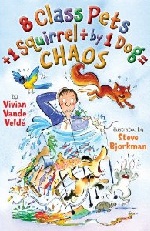 Twitch, the schoolyard squirrel, runs across the snout of Cuddles, the principal’s dog who lives next to the elementary school. Cuddles is not happy about this tromp on his nose and so chases Twitch right into the school building and the fun, rather chaos, begins. Twitch runs from classroom to classroom seeking a way out but leaves a trail of havoc in his wake. Each dash into the classroom happens in order from the first grade classroom to the fifth grade including the library, the art room, and the science lab. As Twitch rushes into each classroom the class pet continues to narrate the action as they observe what is happening. Each pet has its own distinctive language style that will make this book an excellent read aloud or mentor text to discuss different writing styles employed by authors. The library rat, the hamster, the tetras, a rabbit, the geckos (Galileo and Newton), the parrot, snake, and turtle are the classroom pets that narrate each chapter. At the end of the book, Cuddles gets the chance to tell his side of the chase. Teachers might enjoy stopping by the website Pets in the Classroom after reading this book. Vivian’s website offers information behind the story, a video, a Q & A and more for teachers.
Twitch, the schoolyard squirrel, runs across the snout of Cuddles, the principal’s dog who lives next to the elementary school. Cuddles is not happy about this tromp on his nose and so chases Twitch right into the school building and the fun, rather chaos, begins. Twitch runs from classroom to classroom seeking a way out but leaves a trail of havoc in his wake. Each dash into the classroom happens in order from the first grade classroom to the fifth grade including the library, the art room, and the science lab. As Twitch rushes into each classroom the class pet continues to narrate the action as they observe what is happening. Each pet has its own distinctive language style that will make this book an excellent read aloud or mentor text to discuss different writing styles employed by authors. The library rat, the hamster, the tetras, a rabbit, the geckos (Galileo and Newton), the parrot, snake, and turtle are the classroom pets that narrate each chapter. At the end of the book, Cuddles gets the chance to tell his side of the chase. Teachers might enjoy stopping by the website Pets in the Classroom after reading this book. Vivian’s website offers information behind the story, a video, a Q & A and more for teachers.
- Karen Hildebrand, Ohio Library and Reading Consultant
GRADES 5-8
Eamer, Claire. (2012). The World in Your Lunch Box. Illustrated by Sa Boothroyd. Annick Press.
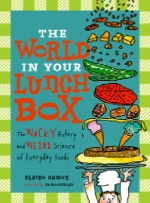 In the atmosphere of health and nutrition and childhood obesity, this nonfiction look at the food in kids’ lunch boxes is presented humorously as well as factually. Divided into seven sections for each day of the week Eamer explores the history and science behind food and lunch choices and even provides jokes relating to food. Foods popularly found in school lunch boxes include watermelon, peanut butter, hot dogs, macaroni, pizza, ham sandwiches, and more. The author discusses the history as to where these foods developed and includes interesting anecdotes about these culinary lunch box delights. A detailed plan for using the author’s lunch box ideas can be found at the publisher’s website for download.
In the atmosphere of health and nutrition and childhood obesity, this nonfiction look at the food in kids’ lunch boxes is presented humorously as well as factually. Divided into seven sections for each day of the week Eamer explores the history and science behind food and lunch choices and even provides jokes relating to food. Foods popularly found in school lunch boxes include watermelon, peanut butter, hot dogs, macaroni, pizza, ham sandwiches, and more. The author discusses the history as to where these foods developed and includes interesting anecdotes about these culinary lunch box delights. A detailed plan for using the author’s lunch box ideas can be found at the publisher’s website for download.
- Karen Hildebrand, Ohio Library and Reading Consultant
Watts, Jeri. (2012). Kizzy Ann Stamps. Candlewick Press.
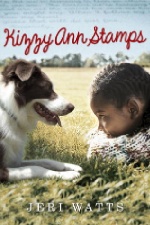 Kizzy is about to enter an integrated school for the first time. It is 1963 and her teacher has asked that students write letters to their new teacher to express their feelings about the transition to an integrated school. Kizzy has mixed feelings about the whole experience but she does like to write so this is a comfortable way for her to communicate what she is feeling. She is self-conscious about the scar across her face as a result of an accident with her white neighbor Frank Charles in addition to being a black student entering a previously all white school. Told in letters and journal entries, Kizzy expresses her anxiety but also her love toward her border collie, Shag, who faithfully stayed by her side during her recovery from the accident. She is determined to enter Shag in the AKC Border collie trials with the help of a trainer, Mr. McKenna. However, she is not sure that the rules will allow a black person to compete. This middle grade novel introduces several layers of discrimination in the life of this young black girl. Another story layer involves her older brother, James, who is a more hostile character than Kizzy about the integration concept. ReadWriteThink offers a lesson entitled “Using Literature to Promote Authentic Letter Writing” that would serve as an extension of this book. Or introduce the book with this short video from Animal Planet on training border collies.
Kizzy is about to enter an integrated school for the first time. It is 1963 and her teacher has asked that students write letters to their new teacher to express their feelings about the transition to an integrated school. Kizzy has mixed feelings about the whole experience but she does like to write so this is a comfortable way for her to communicate what she is feeling. She is self-conscious about the scar across her face as a result of an accident with her white neighbor Frank Charles in addition to being a black student entering a previously all white school. Told in letters and journal entries, Kizzy expresses her anxiety but also her love toward her border collie, Shag, who faithfully stayed by her side during her recovery from the accident. She is determined to enter Shag in the AKC Border collie trials with the help of a trainer, Mr. McKenna. However, she is not sure that the rules will allow a black person to compete. This middle grade novel introduces several layers of discrimination in the life of this young black girl. Another story layer involves her older brother, James, who is a more hostile character than Kizzy about the integration concept. ReadWriteThink offers a lesson entitled “Using Literature to Promote Authentic Letter Writing” that would serve as an extension of this book. Or introduce the book with this short video from Animal Planet on training border collies.
- Karen Hildebrand, Ohio Library and Reading Consultant
GRADES 7-12
Cashman, Erin. (2012). The exceptionals. New York: Holiday House.
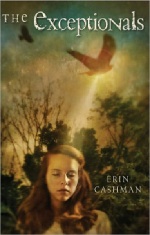 Unlike everyone else in the Walker family, fifteen-year-old Claire has no special powers. Since there is nothing exceptional about her, Claire has attended public school rather than Cambial Academy, a boarding school for students with special talents established by one of her ancestors. After she gets in trouble at the public high school, her parents transfer her to Cambial Academy where she makes friends, finds a home, and begins to hone her own gifts. It seems that Claire has the ability to hear the thoughts of animals, something she has hidden. When several of the most talented students disappear from school, Claire, her family and classmates try to find them while pondering a prophecy that might involve the teenager. Amid all this excitement, Claire meets a mysterious young man in the woods near the school and isn't sure whether to trust him despite their immediate attraction. Readers will enjoy Claire’s evolution and interaction with her hawk friends and her confusion over the two romantic possibilities that present themselves to her.
Unlike everyone else in the Walker family, fifteen-year-old Claire has no special powers. Since there is nothing exceptional about her, Claire has attended public school rather than Cambial Academy, a boarding school for students with special talents established by one of her ancestors. After she gets in trouble at the public high school, her parents transfer her to Cambial Academy where she makes friends, finds a home, and begins to hone her own gifts. It seems that Claire has the ability to hear the thoughts of animals, something she has hidden. When several of the most talented students disappear from school, Claire, her family and classmates try to find them while pondering a prophecy that might involve the teenager. Amid all this excitement, Claire meets a mysterious young man in the woods near the school and isn't sure whether to trust him despite their immediate attraction. Readers will enjoy Claire’s evolution and interaction with her hawk friends and her confusion over the two romantic possibilities that present themselves to her.
- Barbara A. Ward, Washington State University Pullman
Castan, Mike. (2012). Fighting for Dontae. New York: Holiday House.
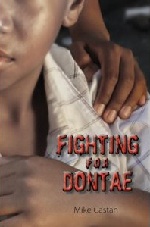 Things couldn’t be much worse for seventh grader Javier. Although his mother works hard, there isn’t enough money for a new pair of cheap running shoes for the first day of school, and he steals the shoes he wants. He and his friends seem headed for disaster as they are drawn into the fringes of the gangsta life because they have little money and few other alternatives present themselves. School has always been boring, for the most part, and when Javier is assigned to work with the youngsters in a special education class, he is less than thrilled since he knows that his peers will ridicule him. For some reason, though, he connects with the students in the class, particularly a boy named Dontae, who loves having Javier read aloud an Ernest Hemingway novel. While Mrs. Aronson, the teacher of the class, is savvy enough to see through some of Javier's defensive behavior and knows that he has light fingers, she also sees his potential. Those who are disinterested in school are likely to find much truth in Javier's story as things improve for him at home and at school. While his future remains in doubt, his renewed sense of purpose seems to predict a much brighter one than what he had on the book’s opening pages. Like many bibliophiles, he seems to realize that reading often offers an escape from the world around him.
Things couldn’t be much worse for seventh grader Javier. Although his mother works hard, there isn’t enough money for a new pair of cheap running shoes for the first day of school, and he steals the shoes he wants. He and his friends seem headed for disaster as they are drawn into the fringes of the gangsta life because they have little money and few other alternatives present themselves. School has always been boring, for the most part, and when Javier is assigned to work with the youngsters in a special education class, he is less than thrilled since he knows that his peers will ridicule him. For some reason, though, he connects with the students in the class, particularly a boy named Dontae, who loves having Javier read aloud an Ernest Hemingway novel. While Mrs. Aronson, the teacher of the class, is savvy enough to see through some of Javier's defensive behavior and knows that he has light fingers, she also sees his potential. Those who are disinterested in school are likely to find much truth in Javier's story as things improve for him at home and at school. While his future remains in doubt, his renewed sense of purpose seems to predict a much brighter one than what he had on the book’s opening pages. Like many bibliophiles, he seems to realize that reading often offers an escape from the world around him.
- Barbara A. Ward, Washington State University Pullman
Sullivan, Mary. (2012). Dear Blue Sky. New York: Penguin/Nancy Paulsen Books.
 Her beloved older brother Sef’s decision to serve in Iraq in 2003 completely rattles the worlds of seventh grader Cassie and her entire family. She misses his strength, his wisdom, and his support, and it seems as though nothing is going right now that he has gone. Her younger brother Jack deals with a cruel neighborhood bully by refusing to speak to anyone, her older sister is involved in an unhealthy relationship that damages her self-esteem, and her best friend Sonia trades in their friendship for popularity. Cassie eventually finds friendship with Kim, another classmate the others have teased, and thanks to a school assignment, she makes friends with an Iraqi girl whose blog and e-mail describe the conditions in the country where Sef is serving. As hard as things may seem for Cassie, she realizes that the girl she knows as Blue Sky is coping with constant threats of violence and death and trying to survive in a world where everything familiar has changed. In fact, her father’s association with the Americans in the past has endangered the family’s lives, and they are forced to leave their home. The emails that fly back and forth between Cassie and Blue Sky and the missives from her brother hinting at the horrors of war make it impossible for Cassie to tolerate some of the judgmental comments of her history teacher. The author creates empathy for both girls and for Cassie's brother, who will never be the same after his experiences in Iraq. The writing is honest, showing the various ways that family members cope with stress, and the storyline provides plenty of material for class discussions on the effects of war on those on the frontline, those left behind, and those in the country where war is being waged.
Her beloved older brother Sef’s decision to serve in Iraq in 2003 completely rattles the worlds of seventh grader Cassie and her entire family. She misses his strength, his wisdom, and his support, and it seems as though nothing is going right now that he has gone. Her younger brother Jack deals with a cruel neighborhood bully by refusing to speak to anyone, her older sister is involved in an unhealthy relationship that damages her self-esteem, and her best friend Sonia trades in their friendship for popularity. Cassie eventually finds friendship with Kim, another classmate the others have teased, and thanks to a school assignment, she makes friends with an Iraqi girl whose blog and e-mail describe the conditions in the country where Sef is serving. As hard as things may seem for Cassie, she realizes that the girl she knows as Blue Sky is coping with constant threats of violence and death and trying to survive in a world where everything familiar has changed. In fact, her father’s association with the Americans in the past has endangered the family’s lives, and they are forced to leave their home. The emails that fly back and forth between Cassie and Blue Sky and the missives from her brother hinting at the horrors of war make it impossible for Cassie to tolerate some of the judgmental comments of her history teacher. The author creates empathy for both girls and for Cassie's brother, who will never be the same after his experiences in Iraq. The writing is honest, showing the various ways that family members cope with stress, and the storyline provides plenty of material for class discussions on the effects of war on those on the frontline, those left behind, and those in the country where war is being waged.
- Barbara A. Ward, Washington State University Pullman
Zeitlin, Meredith. (2012). Freshman Year & Other Unnatural Disasters. New York: Putnam’s Sons.
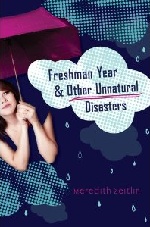 Author Meredith Zeitlin, a voice-over artist, makes her debut as a teen author with fourteen-year old Brooklyn-born character Kelsey Finkelstein as she enters her freshman year in high school. Kelsey is excited and determined to have a stellar freshman experience. As the year unfolds her life as a high school student does not always go as planned. Her fashion statement is always in question, her athletic ability on the JV soccer team leaves something to be desired and her ability as an actress in the school play is probably not going to win an Academy Award. Her romantic inclination toward Jordan is crushed when her friend Cassidy is found making out with him. A new love interest looks like it might be spawning in the form of the school newspaper reporter, so romantic hope is near. Teen issues from alcohol to marijuana, boy-girl and girl-girl relationships, and the value of friendship with the sometimes serious but often hilarious outcomes make this an entertaining introduction to life as a high school freshman. Vimeo has posted a sneak peek book trailer, and the author has an informative website and blog.
Author Meredith Zeitlin, a voice-over artist, makes her debut as a teen author with fourteen-year old Brooklyn-born character Kelsey Finkelstein as she enters her freshman year in high school. Kelsey is excited and determined to have a stellar freshman experience. As the year unfolds her life as a high school student does not always go as planned. Her fashion statement is always in question, her athletic ability on the JV soccer team leaves something to be desired and her ability as an actress in the school play is probably not going to win an Academy Award. Her romantic inclination toward Jordan is crushed when her friend Cassidy is found making out with him. A new love interest looks like it might be spawning in the form of the school newspaper reporter, so romantic hope is near. Teen issues from alcohol to marijuana, boy-girl and girl-girl relationships, and the value of friendship with the sometimes serious but often hilarious outcomes make this an entertaining introduction to life as a high school freshman. Vimeo has posted a sneak peek book trailer, and the author has an informative website and blog.
- Karen Hildebrand, Ohio Library and Reading Consultant
Hautman, Pete. (2012). What boys really want. New York: Scholastic.
 Although Lita and Adam have been friends for a long time, they haven’t always been as honest with each other as they might have been. For instance, Lita, who loves to write, has never told Adam that she blogs as acerbic advice columnist Miz Fitz. In the past, she has even plotted to wreck his previous romantic entanglements for his own good. In fact, she actually plans to do the same with his current attraction to Blair Thompson, a girl she judges as promiscuous because of her appearance. Adam, on the other hand, fails to tell Lita that he's writing a book about what boys really want when it comes to girls and relationships. Desperately looking for ideas for his book and finding writing harder than he had imagined, he searches online for inspiration and incorporates the ideas of other writers. Much of the writing that he has “borrowed” for his book originated in Lita’s blog although he doesn’t know that it’s her writing that he is reading. Naturally, when the truth comes out, the relationship between the two can never be the same. In many respects, this book is about assumptions about others, close calls, near misses, and failure to communicate. The daily drama that typifies high school is at the book’s heart, and if Lita is high strung and more emotionally unbalanced than might be desired, Adam himself seems clueless about basic ethical issues such as plagiarism. While the somewhat smug and clueless Lita justifies her own actions because they’re for the good of others, she fools no one in the end, a lesson worth considering by us all.
Although Lita and Adam have been friends for a long time, they haven’t always been as honest with each other as they might have been. For instance, Lita, who loves to write, has never told Adam that she blogs as acerbic advice columnist Miz Fitz. In the past, she has even plotted to wreck his previous romantic entanglements for his own good. In fact, she actually plans to do the same with his current attraction to Blair Thompson, a girl she judges as promiscuous because of her appearance. Adam, on the other hand, fails to tell Lita that he's writing a book about what boys really want when it comes to girls and relationships. Desperately looking for ideas for his book and finding writing harder than he had imagined, he searches online for inspiration and incorporates the ideas of other writers. Much of the writing that he has “borrowed” for his book originated in Lita’s blog although he doesn’t know that it’s her writing that he is reading. Naturally, when the truth comes out, the relationship between the two can never be the same. In many respects, this book is about assumptions about others, close calls, near misses, and failure to communicate. The daily drama that typifies high school is at the book’s heart, and if Lita is high strung and more emotionally unbalanced than might be desired, Adam himself seems clueless about basic ethical issues such as plagiarism. While the somewhat smug and clueless Lita justifies her own actions because they’re for the good of others, she fools no one in the end, a lesson worth considering by us all.
- Barbara A. Ward, Washington State University Pullman
ReadWriteThink.org is
a website devoted to providing literacy instruction and interactive
resources for grades K–12 from the International Reading Association, the National Council
of Teachers of English, and Verizon Thinkfinity.
This set of book reviews is a weekly contribution of the Children's Literature and Reading Special Interest Group (CL/R SIG).